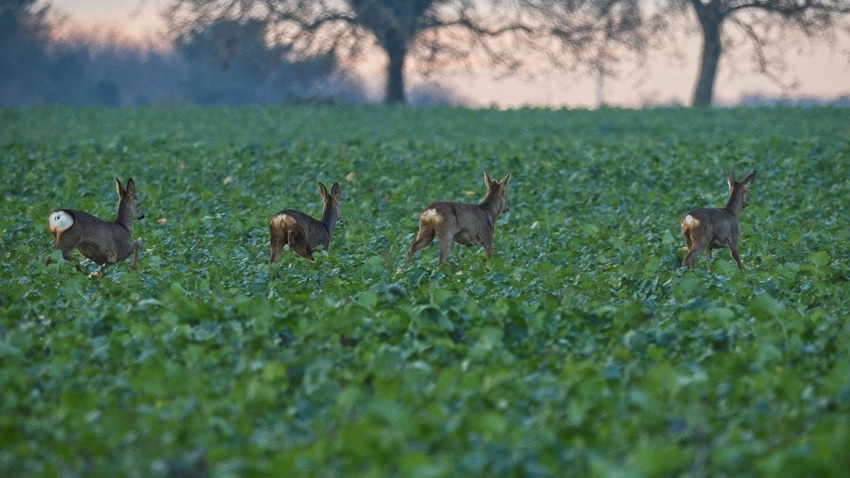
At a Glance
- $114 million total loss is based on losing 13 to 14 bushels per acre on South Carolina’s roughly 405,000 soybean acres.
- Figures are crude extrapolations and should be considered very crude estimates given the limited data currently available.
Cory Heaton received more calls in 2023 from farmers on deer damage to South Carolina crops in all of his 23 years working as a Clemson University wildlife specialist.
The numbers are staggering. Research by Clemson University pegs the estimated loss to cotton, soybean, and peanut farmers was roughly $114 million in 2022. Heaton points out the $114 million figure does not include expenses for deer induced replating, additional herbicide applications, additional repellents, and other such costs.
He notes the figures are crude extrapolations and should be considered very crude estimates given the limited data currently available. He said the good news is Clemson researchers are seeking solutions to the problem.
Tracking routes and numbers
“Each year the first thing that we have tried to focus on is determining how many deer are actually out there. We set up these survey routes in rural areas of the state. We are not just counting deer in the fields. We have established survey routes that we have set out and planned out thoroughly,” Heaton said in a presentation at the South Carolina Corn and Soybean Growers Annual Meeting, Dec. 14 at the Santee Conference Center.
“We are covering a very good representation of what happens in these rural counties. We’re looking at planted pines. We’re looking at natural forests. We’re looking at ag fields. We’re looking at hay fields. We’re looking at trailer parks, cemeteries, churches,” he said.
He called the findings an eye opener. In routes where they were supposed to see 20 to 30 deer per square mile, they actually saw, over a three-night average on each of the routes they surveyed, more than 100 deer per square mile.
“We had multiple routes in some of these counties to verify what we were seeing. That population is going to vary throughout that county. It’s going to vary from area to area within a county. It’s not going to be consistent across a whole county,” Heaton said.
The $114 million total loss is based on losing 13 to 14 bushels per acre on South Carolina’s roughly 405,000 soybean acres. Total loss is estimated at 3.8 million bushels with an estimated average dollar loss of $175 per acre to South Carolina soybean growers. This translates to a $52 million decrease in soybean yield revenue. The numbers come from Clemson’s cage studies.
For cotton, the loss was pegged at 366 pounds of lint per acre on South Carolina’s roughly 270,000 cotton acres. This translates to a loss of $243 per acre for a total loss of 55.6 million pounds of lint. The total loss attributed to deer to cotton was $46 million.
For peanuts, the average loss on South Carolina’s 84,000 peanut acres was pegged at 753 pounds per acre. This translates to a loss of $188 per acre for a total loss of 63.2 million pounds for a total loss of $15.8 million.
“If you ride around and look at soybeans in this state, you’ll understand this. As much pressure you put on those deer with a rifle, it doesn’t matter how much money you spend on repellents, we are unable to prevent extensive damage when you have deer densities that high,” Heaton said.
Determining deer damage
Heaton said using the exclusion cages is one good way to figure out how much damage deer are causing to soybeans and other South Carolina crops.
“We’re putting exclusion cages in that field that keep the deer from getting out. You have to make the cages small. If you make them big, deer just jump into them. If you make them small, they feed around them. We put these exclusion cages where we anticipate deer damage will be a little higher. We are also putting these cages up where we expect damage to be the lowest. This gives us figures somewhere in the middle of what is actually going on.”
For soybeans in 2022, the research shows soybean farmers were losing roughly one plant per plot which translated to 13,000 plants per acre. “You take 13,000 plants per acre out across the whole 405,000 acres of soybeans that were in the ground, that’s a lot of plants that didn’t make it to that harvester. That’s a lot of yield that walked away,” Heaton said.
Heaton said damage to peanuts is different than damage to cotton and soybeans.
“Our damage in peanuts is minor when we’re in the growing stage. The actual damage to peanuts is showing up actually after we dig peanuts so that window from when we dig to when we harvest becomes really important. As fast as you can get those peanuts to go into that combine, the better off you are. Every day you wait, it’s just more peanuts that aren’t going to go in that combine. The deer are going to eat them. It was significant to the point of 750 pounds per acre that was walking off the field after we dig,” he said.
Read more about:
DeerAbout the Author(s)
You May Also Like






